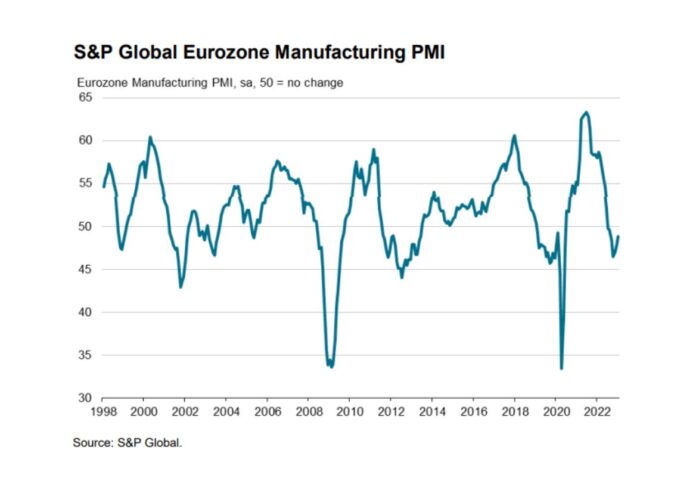
Manufacturing in the Eurozone continued its streak in the contraction territory in the first month of 2023, dragged by downturns in production volumes and new factory orders.
The latest S&P Global Eurozone Manufacturing PMI reading rose for a third successive month to 48.8 in January, up from 47.8 in December.
The reading, which is still below the 50.0 mark, is the highest since last August, despite indicating a worsening in the health of the euro area’s manufacturing industry.
However, both indices have shown slower rates of contraction, tentatively suggesting that the worst of the manufacturing sector’s slump has passed, S&P Global said in its latest Eurozone Manufacturing PMI report, noting that the survey also found expansions in output in some parts of the euro area in January.
Meanwhile, stocks of finished goods declined for the first time since May 2022.
Pre-production holdings remained flat, indicating manufacturers’ efforts to align inventories with the prevailing economic environment.
On the other hand, purchasing activity continued to decline, while suppliers’ delivery times remained generally stable. These two factors helped reduce cost pressures across the euro area, with input price inflation slowing to a 26-month low.
Eurozone’s output slipped further in January, extending the current sequence of contradiction which began in mid-2022. The decline, however, was marginal and the slowest in seven months. S&P Global attributes the slump to weak demand pressures, which dragged production schedules.
“Although euro area manufacturers continued to report falling output and deteriorating order books in January, sustaining the sector’s downturn for an eighth successive month, the picture is considerably brighter than the lows seen back in last October heading into the winter,” said Chris Williamson, the chief business economist at S&P Global Market Intelligence.
“Worries over gas supply constraints and soaring gas costs have given way to a much more stable-looking energy market in Europe, albeit thanks in part to state subsidies and mild weather. At the same time, broader supply chain constraints have eased considerably, helping many companies reduce their backlogs of work and ramp up production.”



















